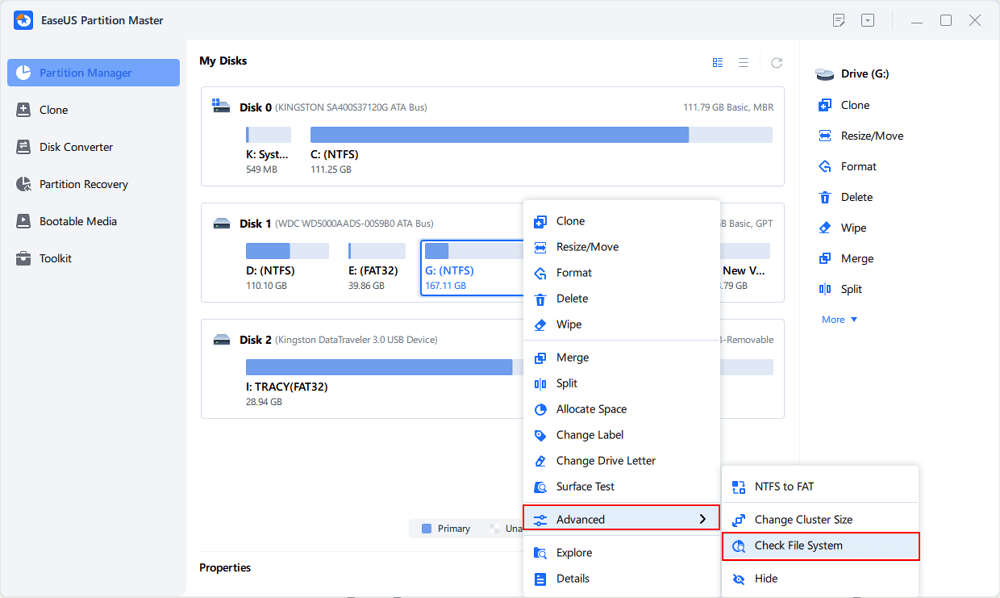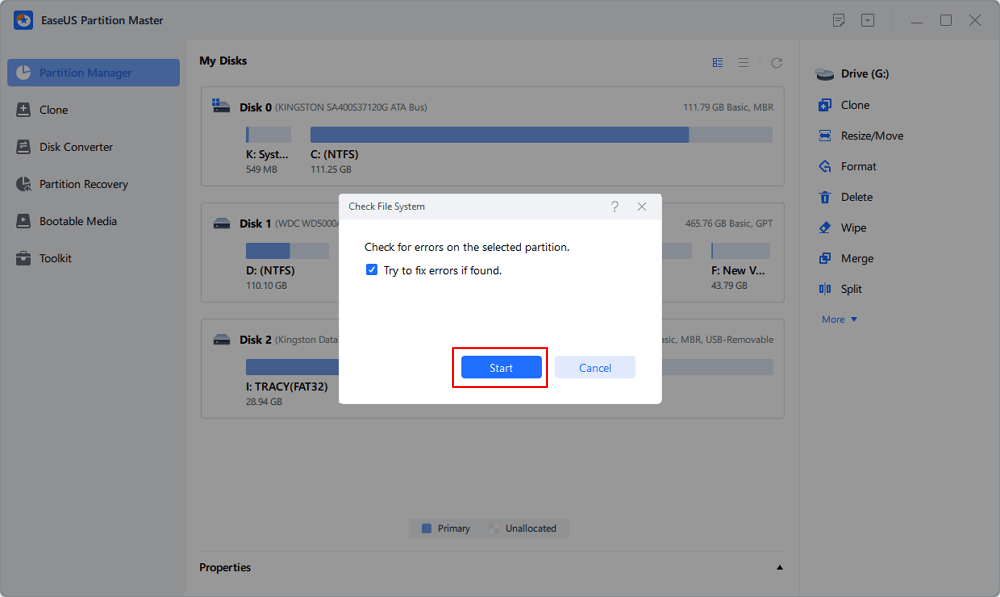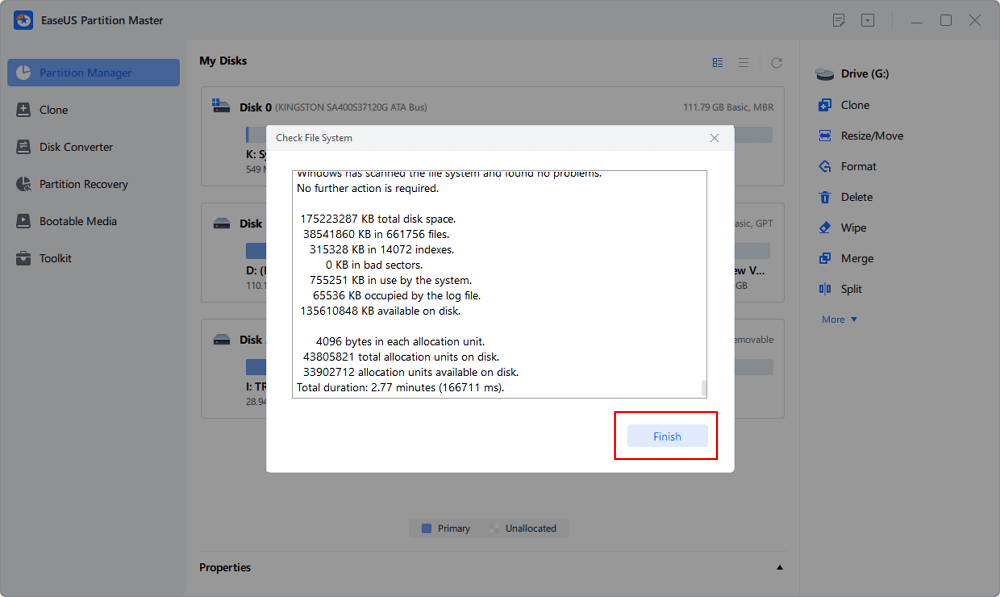Start Your Free Trial!
Sign up to our newsletter, stay updated on news and exclusive offers from EaseUS. Don't worry, if you change your mind, you can unsubscribe at any time, free of charge. We value your privacy (Privacy Policy).
Page Table of Contents
How to Fix Can't Open USB Drive on Windows 11/10HOT
Why Can't I Open the USB Flash DriveHOT
Final WordsHOT
Can't Open USB Drive FAQsHOT
About the Author
Hot Topics
Updated on Apr 28, 2025
One of the issues that users commonly find after upgrading to Windows 11/10 is that they can't open USB drive. Updating to Windows 11/10 can be seamless, except for opening the USB drive to retrieve the required data.
If you are in such a situation as well, this article from EaseUS will help you fix it quickly. So, jump right in, and let's fix the issue.
Whatever the reason, the following are some methods by which you can solve the problem of not opening a USB drive. Try any of the ways, depending on the cause of the issue, and you will be good to go.
| Basic Troubleshooting | Advanced Troubleshooting |
|---|---|
|
1. Insert the USB Drive into Another PC |
6. Repair File System Errors 7. Check Bad Sectors |
A common reason for being unable to open your USB drive can be due to damage in the USB port of your device or a broken USB drive. To ensure that the drive or the port is in good condition, connect it to another PC or laptop.
The drive will work if the original PC's port is damaged; if it doesn't, check if it is showing on Disk Management. If not, your USB drive is broken and needs to be replaced with a new one.
If your USB drive can't even be recognized and viewed in the File Explorer, go to the following page for corresponding solutions.
If your USB drive can be viewed in the File Explorer but still cannot be accessed, try changing your USB drive letter. You can do it through simple steps using Disk Management.
Step 1. Search for and open "Disk Management" from the Start menu.
Step 2. A layout of partitions will appear. Now, select the USB drive and right-click on it. Click on the option "Change Drive Letter and Path."
Step 3. Select "Change" and provide the new path. Then, hit "OK" to change the drive letter.

Creating at least one partition for your USB drive can be a solution to make it work again. Partition of your USB drive is splitting the drive into various segments, which your device will access separately. For this, follow the following steps:
Step 1. Right-click on the Start menu icon and open Disk Management. On your USB drive, right-click the unallocated part, select "New Simple Volume" and click "Next."
Step 2. Now, enter the size of the volume you wish to create or choose the maximum default size. Again, click on "Next."
Step 3. A new dialogue box appears, giving you the choice to format or not format the drive. You can choose your preferred option, select "Next," and click "Finish."

Follow this method if your USB drive cannot be seen in the Disk Manager. The best solution is to reinstall the USB controllers using the steps below.
Step 1. In the Start menu, search for "Device Manager" and open it.
Step 2. Right-click on the USB Mass Storage controller and select "Uninstall" to remove it.

Step 3. Once the controllers are uninstalled, restart the computer, and the USB controllers will be reinstalled automatically. Then, check if the USB drive can be opened and work.
If the file system of the USB drive is not compatible with your Windows OS, you should try reformatting it to make it recognizable on your computer.
Step 1. First, plug your drive into the USB port of your PC or laptop. This method would be helpful if you could view your drive in File Explorer.
Step 2. Once you locate your drive, right-click on it and select the "Format" option. Select another file system and start the process.
Step 3. The formatting will take a few minutes, and a reformatted USB drive will be available.
If your USB drive is not showing up in File Explorer, you can try methods on the page below to format it.
If the faulty file system is the root cause, try repairing it. For this, you can use an efficient tool like EaseUS Partition Master Free to rectify your problem effortlessly. It is an all-in-one partition manager tool with many useful features.
One such feature is "Check File System," which scans the disk and fixes corrupted file systems. This will enable the repair of the USB drive and make it work again to access the needed data. Here's the step-by-step guide on how to use it:
Step 1. Open EaseUS Partition Master on your computer. Then, locate the disk, right-click the partition you want to check, and choose "Advanced" > "Check File System".

Step 2. In the Check File System window, keep the "Try to fix errors if found" option selected and click "Start".

Step 3. The software will begin checking your partition file system on your disk. When it completes, click "Finish".

You can't open the USB drive when it is corrupted or contains bad sectors. In such cases, the problem can be fixed by running the CHKDSK command: chkdsk E: /f /r /x (Replace "E" with your USB drive letter). It fixes any errors on the disk and locates and repairs bad sectors.
You can also use EaseUS Partition Master to perform an in-depth scan of bad sectors and fix the issue immediately.
Here are the steps on how to do so:
Step 1. Open EaseUS Partition Master. Go to Toolkit and select "Bad Sector Scan."
Step 2. Tick "Scan Disk" and choose the target disk from the drop-down menu.
Step 3. Click "Scan" to apply the bad sector scaning process.
After getting your USB drive accessible, you might need help from the following page to recover the partition on the drive if there's data loss.

4 Steps to Recover Deleted or Lost Partition
With detailed instructions in this article, you can recover deleted or lost partitions in Windows XP/Vista/7/8/8.1/10/11 and Windows Server 2003/2008/2012. Read more >>
The reason for not being able to open your USB drive can be anything from a simple issue to a technical error. Whatever the reason, it is helpful to understand the problem before finding ways to fix it. The following are some of the reasons why you can't open a USB drive:
Once you have identified the reason, dive into the next session to get the best method for fixing this issue. Share this article so that others facing similar issues can get simple and quick solutions in no time.
It is always better to tackle the reason for the problem first so that a suitable method can be chosen as a solution. Any of these methods, along with handy tools such as EaseUS Partition Master, can help you solve the case of being unable to open a USB drive. Additionally, EaseUS Partition Master offers many free features to help users fix errors on the drives.
If you have any more doubts about why your USB drive is not accessible, refer to the commonly asked questions below.
You can't read your USB drive for many reasons, from the damaged drive to the corrupted file systems. Following are some of the common reasons why you can't read your USB drive:
Your USB drive will not be detected if it is broken or if the USB port of your PC or laptop is damaged. Always check it once with another device and see which factor is the issue. If it is the port, the drive will work on another device. If it is the drive, it will not be visible in the Disk Management.
If you can see the USB drive on File Explorer but cannot access it, try any of the following methods to solve it:
How Can We Help You
Oliver is an EaseUS professional writer who dares explore new areas. With a passion for solving tech issues with straightforward guides for common users, Oliver keeps honing his writing craft by developing in-depth solutions for disk and partition management, computer boot-up issues, file transfer, etc.
It won't hot image your drives or align them, but since it's coupled with a partition manager, it allows you do perform many tasks at once, instead of just cloning drives. You can move partitions around, resize them, defragment, and more, along with the other tools you'd expect from a cloning tool.
Read MoreI love that the changes you make with EaseUS Partition Master Free aren't immediately applied to the disks. It makes it way easier to play out what will happen after you've made all the changes. I also think the overall look and feel of EaseUS Partition Master Free makes whatever you're doing with your computer's partitions easy.
Read MorePartition Master Free can Resize, Move, Merge, Migrate, and Copy disks or partitions; convert to local, change label, defragment, check and explore partition; and much more. A premium upgrade adds free tech support and the ability to resize dynamic volumes.
Read MoreIt won't hot image your drives or align them, but since it's coupled with a partition manager, it allows you do perform many tasks at once, instead of just cloning drives. You can move partitions around, resize them, defragment, and more, along with the other tools you'd expect from a cloning tool.
Read MoreI love that the changes you make with EaseUS Partition Master Free aren't immediately applied to the disks. It makes it way easier to play out what will happen after you've made all the changes. I also think the overall look and feel of EaseUS Partition Master Free makes whatever you're doing with your computer's partitions easy.
Read MoreRelated Articles
How to Reset Windows Vista Password | All Situations
![]() Cici/2025/04/28
Cici/2025/04/28
How to Extend Partition in Windows 7 without Data Loss🚀
![]() Jean/2025/04/28
Jean/2025/04/28
How to Shrink Volume with Unmovable Files - 2 Ways
![]() Sherly/2025/04/28
Sherly/2025/04/28
How to Recover Accidentally Deleted Operating System in Windows 11/10
![]() Jean/2025/04/28
Jean/2025/04/28
EaseUS Partition Master

Manage partitions and optimize disks efficiently
Your best companion for disk partitioning, MBR to GPT/GPT to MBR conversion,even OS migration
CHOOSE YOUR REGION
Start Your Free Trial!
Sign up to our newsletter, stay updated on news and exclusive offers from EaseUS. Don't worry, if you change your mind, you can unsubscribe at any time, free of charge. We value your privacy (Privacy Policy).
Start Your Free Trial!
Sign up to our newsletter, stay updated on news and exclusive offers from EaseUS. Don't worry, if you change your mind, you can unsubscribe at any time, free of charge. We value your privacy (Privacy Policy).